Matt Roper:

August 2019
Brothers, and sisters, friends, it’s good to be here today. I see how this goes today. Thirteen years ago last Sunday, celebrating the birth of Joseph Smith, Dr. John Clark, Wade Ardern, and myself gave a presentation at the FAIR Conference, a version of which was also presented at a conference of scholars at the Library of Congress on the anniversary of Joseph Smith’s birthday.
The purpose of that presentation was to present our initial findings on a project exploring how well the Book of Mormon has fared in terms of science and archeological discovery.
After presenting our initial findings (some of you may have even seen a chart like this);
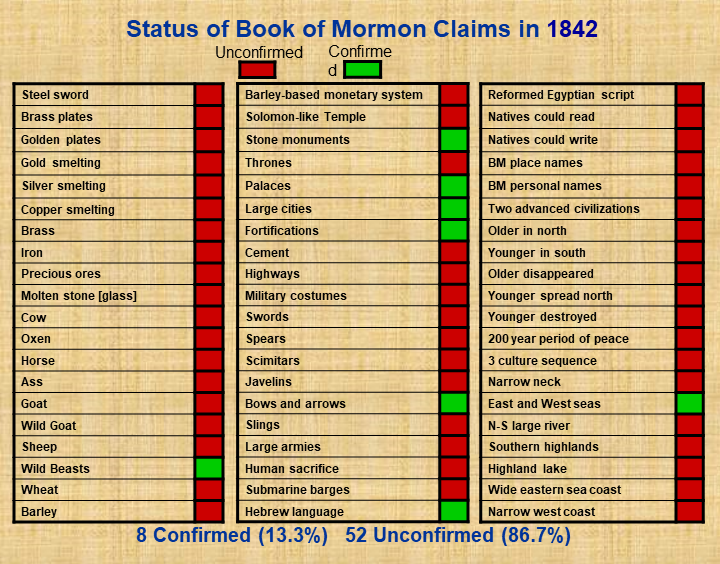
there are several of them that have circulated based on our findings there–back 13 years ago. We were all unfortunately unable to continue with our project at that time. Recently however, I was situated to be able to revisit research from my contribution to that project and have been working to revise and expand that analysis beyond our initial findings.
Today I’d like to share some of the results of that work, which I expect to publish and make generally available along with all the relevant documentation. So hopefully by the end of the year we’ll be able to do that for you.
Before I get into what I just mentioned, I want to spend a few minutes discussing briefly some of the challenges that we face to faith and offer some thoughts about it.
You know one of the themes of the Book of Mormon is it talks a lot about blindness. And when you think about blindness, there are lots of things that can impede our vision. Some of us are farsighted or nearsighted. I have friends that are colorblind. I even have a friend that has a prosthetic eye. There are different things that can happen to your eyes that will obscure your vision, and if you’re not careful, that can lead you into all kinds of trouble and you’ll end up like my grandma was a few years back when I was in the car with her and she was driving down the streets of Gallup, New Mexico, and really frightened me. And she was very confident, but I was not.
There are things however that we can generally do to correct our vision, whether it’s glasses, contact lenses, medicine, surgery, there are things that can happen that can help us so that our vision is not obscured. Now again we’re talking about challenges to faith. I’m going to read this, and you’re familiar with this in the Book of Mormon as we talk about Lehi’s dream and Nephi’s vision.

And Lehi says, “And it came to pass that there arose a mist of darkness, even an exceedingly great mist of darkness, insomuch that they who had commenced in the path did lose their way, that they wandered off and were lost.” Now Nephi in his vision points out that these mists of darkness are the “temptations of the devil, which blind the eyes, and harden the hearts of the children of men, and lead them away into broad roads, that they perish and are lost.” So these mists of darkness can be really a problem.
Now as we experience challenges to faith, it’s probably good to ask, what causes this blindness? We know that the Adversary wants to lead us astray. He wants to make us miserable and eventually destroy us.
So how is it that we become blind? Now this is a picture that kind of makes me think. I like it.

We’ll call her Sister Jones here. She’s worked her way up the path. She’s exercised faith. She got to the tree. She’s even partaken of the fruit, and now where are her eyes? If you notice, she’s not looking at the tree anymore. She’s not even looking at the fruit that’s right there in her hands. But her eyes are glancing across the way at that risky piece of real estate hanging over a cliff. In either case, whether we’re a people who are on the path and encounter the mists of darkness, or whether we are looking past [what] we have in our own hands and across the river to that great and spacious building, we are tempted by things that are not truly as they are, and we need a correction in our vision.
Now there are lots of things that we encounter in life, and this is just one. And again, we talk about the CES Letter, which some are familiar with. This is just the latest iteration of this kind of thing. Again the issue here is not an issue of asking questions or of having questions. The issue is how we frame questions. And also the problem here is one of distorting the perspective of those who go to something like this as a resource to answer their questions.
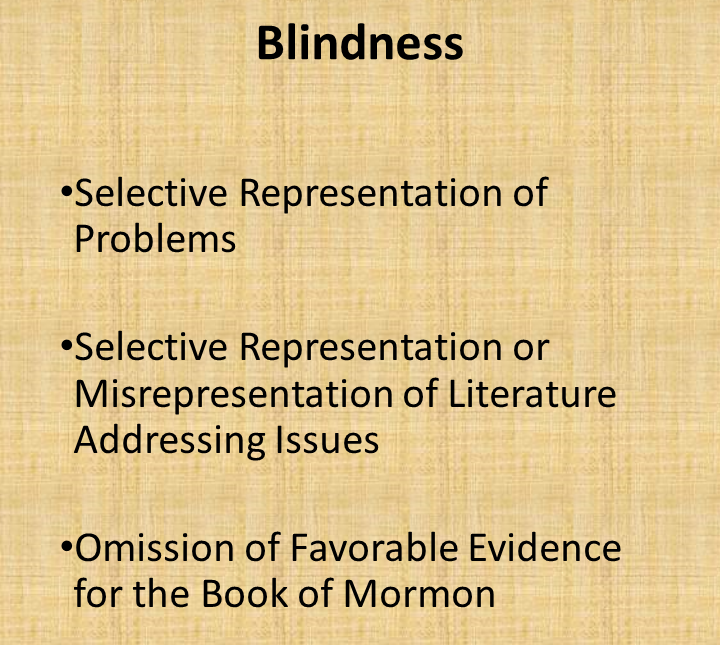
One of the problems we encounter with that and a lot of sources that criticize the Book of Mormon, you have selective representation of the problems that people mention about the Book of Mormon. Also you have a selective representation and even a misrepresentation of literature that has already addressed those issues, which a person who goes to that resource won’t even know are there.
Another aspect that distorts our perspective is the omission of favorable evidence for the Book of Mormon, which is usually completely omitted. So the person who goes to such a resource for answers to their questions frequently finds a very distorted perspective, kind of like a carnival funhouse and a house of mirrors, where you only have a caricature of what a defense of the Book of Mormon might even look like.
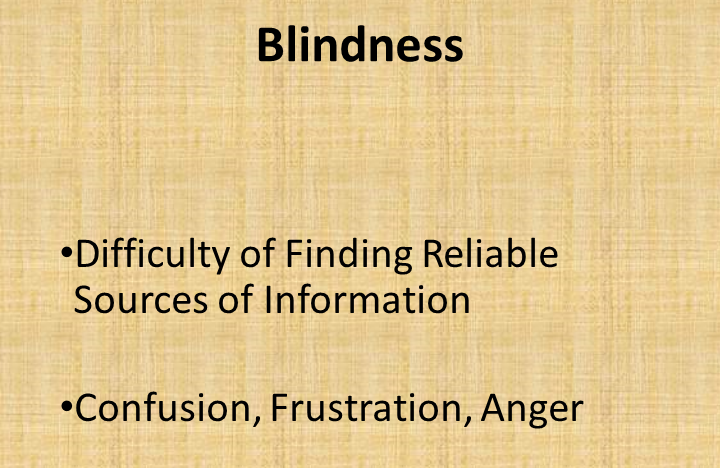
So the person is left, since they’ve had difficulty finding another reliable source’s information, they’re left in confusion, frustration, and anger, and may give up on the faith altogether.
So we have this blindness. How do we deal with that fog that we have to deal with? How do we reduce the blindness that is caused by those mists of darkness that cover our eyes, or at least distort or only give us a partial perspective.
Now I’m going to talk about blindness here again in just a minute, but let me just go here real quick to suggest one thing to preface what I’m going to go into in my current research. There are things that we can do before we have a faith crisis, and that we should all be doing right now. If you haven’t had a faith crisis at some point in your life, you’re going to have a faith crisis.
Most of us have faith crises throughout our lives. One thing that we can do right now to prepare is to seek for more knowledge if we lack knowledge, to seek for more wisdom if we lack wisdom. And I like this counsel from the Lord in the Doctrine and Covenants, “as all have not faith, seek ye diligently and teach one another words of wisdom; yea seek ye out of the best books words of wisdom; seek learning even by study and also by faith.”
The thing I like about this scripture is it notes that “as all have not faith,” not everybody has faith, and not everybody has faith in a particular principle. So there are times in our life, there are things in our life that perhaps we struggle with that maybe we haven’t really exercised our faith to understand.
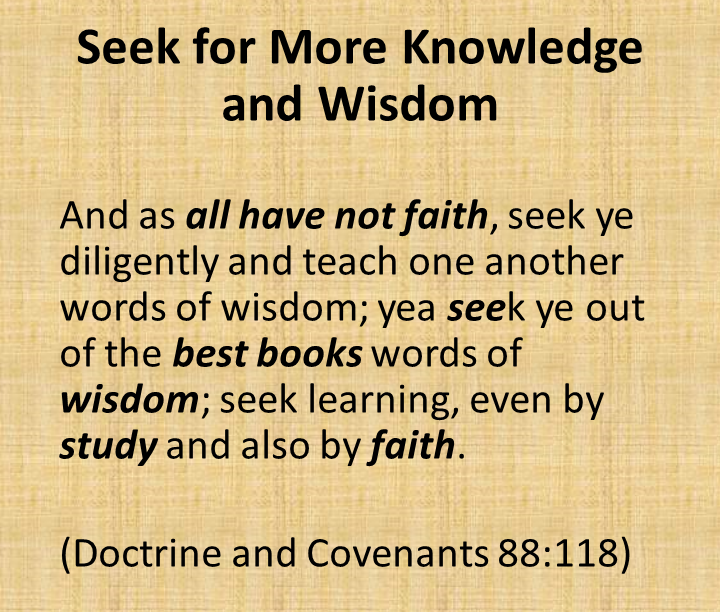
So the Lord understands this, and He says, okay, if you don’t have faith, here’s what you do, but you need to seek out of the best resources that are available. And if you do, and if you do it diligently, and you’re truly seeking, you can find wisdom, and you can find knowledge that then can help you build faiths and then you’ll gain additional knowledge with the faith that you’re able to exercise. And so we need to seek for better knowledge.
Now I noticed recently Elder Ballard gave some counsel, and he talks about how even sometimes general authorities have questions that they don’t have a ready answer for. We tend to think that the General Authorities know everything. Well, they do when the Lord wants them to know things. Okay? But he notes here that there are some times when he has questions. And what does he do?

He goes to people who have more information than he does who specialize in those particular areas. If I wanted to learn about soil archaeology in Mesoamerica, I wouldn’t go to my mother-in-law, although she is an authority on many other things. I’d go to somebody like Richard Hansen, or Brother Richard Terry here who spoke to us, or John Clark. Okay? And I would go to them for expertise and insight.
And he noticed that—in order to get the Holy Ghost to help you, as part of the preparation we need to do is go to the right resources and learn as much as we can. And he also gives some caution for us, and this is true for us personally as well as when we try to help other people. We don’t want to increase the fog on the path or increase the fog that obscures a person’s vision.

“Do not pass along faith-promoting or unsubstantiated rumors or outdated understandings and explanations of our doctrine and practices from the past. It’s always wise to … Consult the works of recognize, and thoughtful, faithful LDS scholars to ensure you do not teach things that are untrue, out of date, or odd and quirky.” And again, that’s good counsel that I would suggest to you.
Now what I’m going to talk about for the rest of my time here is what I mentioned at the beginning, how has the Book of Mormon done over time?
When we started off our official project, back in 2005, that was what we wanted to do. And we were looking specifically at scientific evidence, evidence from archaeology and so forth. Today in what I have been doing, I have expanded this a little. I’ve taken a little bit broader approach, since I’m not an archaeologist, but I have followed some of the discussion about Book of Mormon criticisms over the years.
So let me show you how I have approached the subject. If you look at the galaxy of Book of Mormon criticisms, there’s a constellation of different questions that could be raised and have been raised about the Book of Mormon.

Some deal with 19th century explanations attempts to show the Book of Mormon is manmade, or possible sources of somebody if they were creating the Book of Mormon, theological objections, church history things. All of these are interesting subjects that you can see.
I am focusing on what you see and read there, anachronisms, these are things that people beginning in Joseph Smith’s day, even before the Book of Mormon was published were pointing out about the Book of Mormon that they thought were ridiculous, wrong, or absurd.

So these are the kinds of arguments that you see when we talk about anachronisms, things relating to ancient warfare, ancient swords for example, metals, animals, ancient culture, Lehi’s wilderness trail, Book of Mormon names, events in Third Nephi when the Savior died. These are the kinds of things that people have said. Well, that’s just too absurd for words.

So the way that I have approached this is I’ve had to go through, and this is actually quite a task, to review all anti-Mormon literature on the Book of Mormon from 1830-2019. And I have gone through about 1,000 publications that deal with arguments against the Book of Mormon since Joseph Smith’s day. Divide these criticisms into time periods, 1830-1844, and we’ll talk about—that’s the first time period. 1845-1965; 1966 to our present day, and then document all the criticisms of the Book of Mormon for each time period, because they’re not—not everybody brings up the same thing. Document confirmations, if any, that are based on new information and discoveries during that time period, and then tally the number of non-confirmations or confirmations, be that as it may. So that is the approach that I have taken.

Now I want to specify, too, that I’m not attempting to show or establish what may or may not have been known in Joseph Smith’s day. Now that’s an interesting subject, and some of us have looked at that. But that’s not what I’m going to talk about today. And again I’m not addressing all issues or questions, or possible criticisms of the Book of Mormon. We’re specifically looking at anachronisms. And this is important, we’re taking what the critics themselves have said and tracking the status of those issues that they raised. Okay? So we’re going to take them at their word, even though some of these arguments aren’t particularly good.

All right. So here we are. Now this is how we’re going to score these: unconfirmed category, trending, and confirmed. Okay? So the “unconfirmed” will be in red, example pre-Columbian steel. There are no examples of pre-Columbian steel that have been located by archaeologists. Okay? So that has not been confirmed. That would be an example.
The trending, that is not yet confirmed, but the issue has moved to a more favorable perspective than before. An example of this is the bow and arrow. Now Indians had bows and arrows. They had bows and arrows throughout North and South America. But the issue has more recently been that the bow and arrow wasn’t there early enough for the Book of Mormon. The Book of Mormon mentions the bow and arrow. As time has gone by, the evidence for the bow and arrow has been found to be earlier and earlier, particularly in Mesoamerica, although there is some question as to whether it even existed in Book of Mormon times. But the trend has been showing with recent discoveries including at Aquateca and at I think it was Copán just a few years ago, where they have now found examples of bow and arrow in some of the ruins there, down to the Classic Period at Copán for example.
And then you have confirmed, which would be an example of a pre-Columbian cement 2,000 years ago. So these are things that I have definitely been confirmed. So that’s how we’re scoring things.

Here we go. So our first time period we’re going to look at 1830-1844. So the time the Book of Mormon is published to the year of Joseph Smith’s death.

And if you look at this, we find that there were in those years 89 anachronisms that were mentioned by critics of the Book of Mormon, that were published during that period—89. Okay?
And so if we take these and we put them on a chart, I’ll go back a little bit, we put them on a chart that looks something like this.


You see the red again for the things that haven’t been confirmed, that seem like a problem. And green, if you look at the two pages on this chart, the green means confirmed. There are only about five of these by the time that Joseph Smith was killed, that had been confirmed, and then you see one that’s trending there. Okay. But I think that probably should be green as well. So you have five with new discoveries, that have been confirmed out of the 89 anachronisms, 84 that were unconfirmed when Joseph Smith was murdered. Okay? So that’s your first period there.

So now let’s go on, and let’s take a look at the next time period, the next 120 years, 1845-1965.
Now this you see, this is The Golden Bible, which was M. T. Lamb, who was a big anti-Mormon in the 1880s, and Cumorah Revisited, which was—by Charles Shook—and was a major refutation of the mound-builder theory as applied to the Book of Mormon and kind of representative of the age.

So we had these criticisms that were raised. And now we’re in the second time period, this is what we have. Okay. You can see the chart now. It’s a little bit of change there, you can see. Again the red—let me go back. So 150 Book of Mormon anachronisms at that point.


That’s plus 61 since Joseph Smith’s death. So you’ve got 150 problems that critics have said were problems about the Book of Mormon in those categories. Alright? So you put them on a chart here. Again you see there has been some more changes. It looks a little bit better than at the time of Joseph Smith’s death. And you see that there have been a few more confirmations and a few things that seem to be trending in a more positive direction during that time period. So this is what the tally by 1965 would be, 150 anachronisms, plus 60 since 1844; 22 confirmations, and that would be plus 17 since 1844. So you could see there’s been some positive things happening. Plus 5 that are trending, and if you add those two together you’d have 27 that are either confirmed or trending toward confirmation. But you’ve still got 123 that have not been confirmed. There’s no confirmation for the Book of Mormon.

Now why did I divide this up? Why did I end at 1965? On the next one we’re going to look at this next time period here.
But why 1966? Why do we start there? Well, it’s a personal reason.
I was born in 1966. I know that some of you regret that event, but that is the way it is. Live with it. And I was curious to see what has happened since I was born as far as Book of Mormon criticisms and what has happened. So I was curious about this. And so this is our third time period between 1966 and today, 2019. Okay?

Two hundred and five Book of Mormon anachronisms have been raised since the Book of Mormon was published as mentioned by critics, plus 55 since 1965. So since I was born, and it’s all my fault, there’s 55 additional criticisms there.

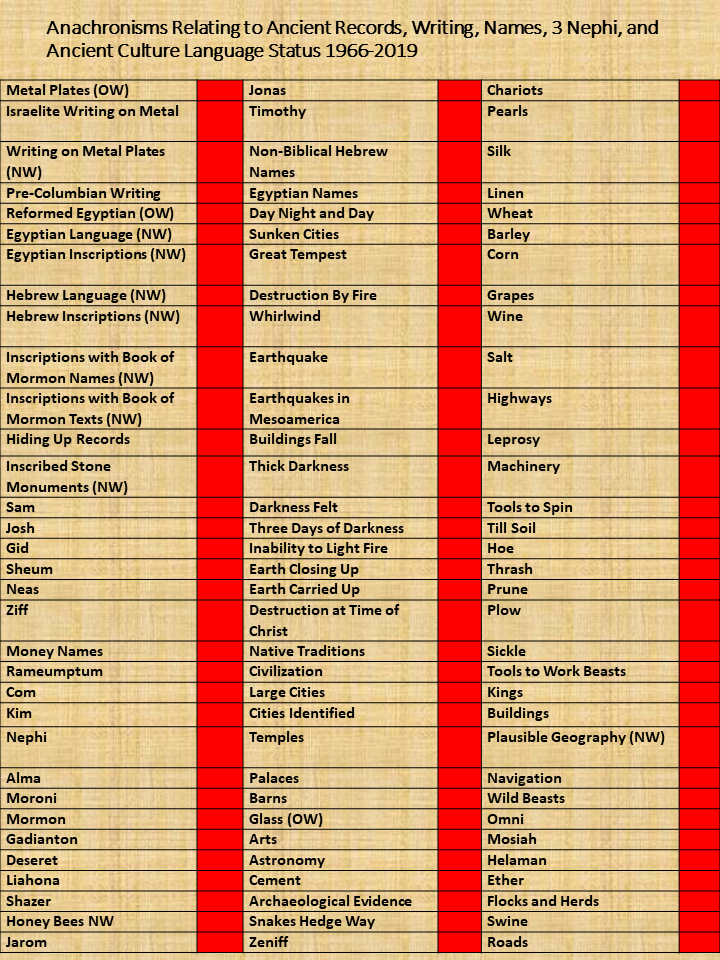
Now we take our list, remember these are all the criticisms that we have here. And we have a chart with all these zeros on it here, if you took them—but again what we want to look at is what’s changed? So this is what we do. So plus 55 criticisms, so we’ve got 205 here. So how does that look as of 2019 in terms of unconfirmed, confirmed, and trending?
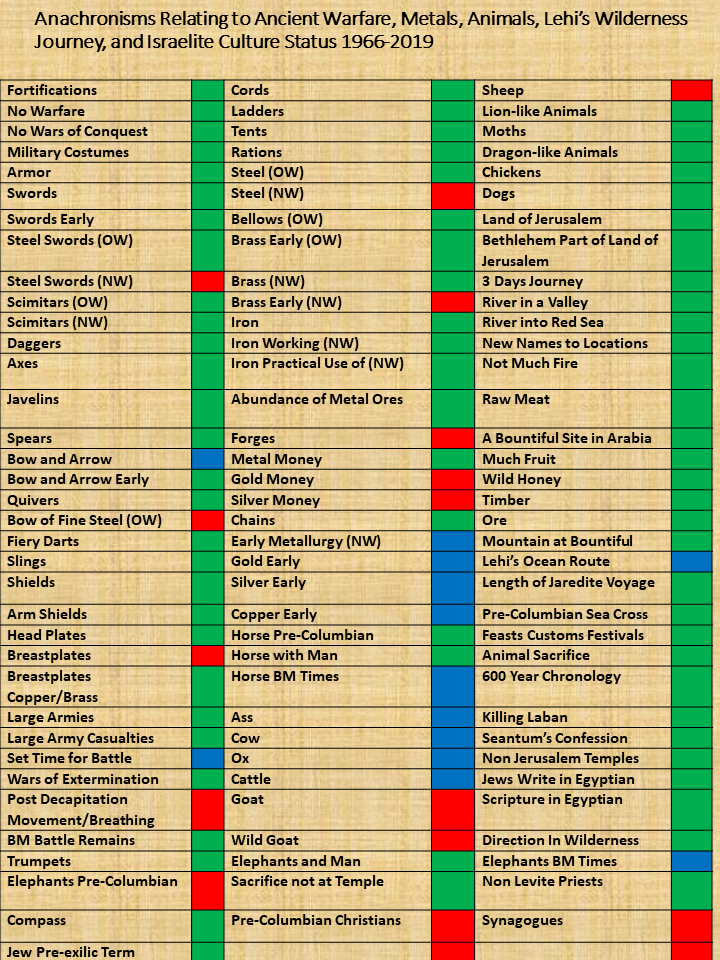
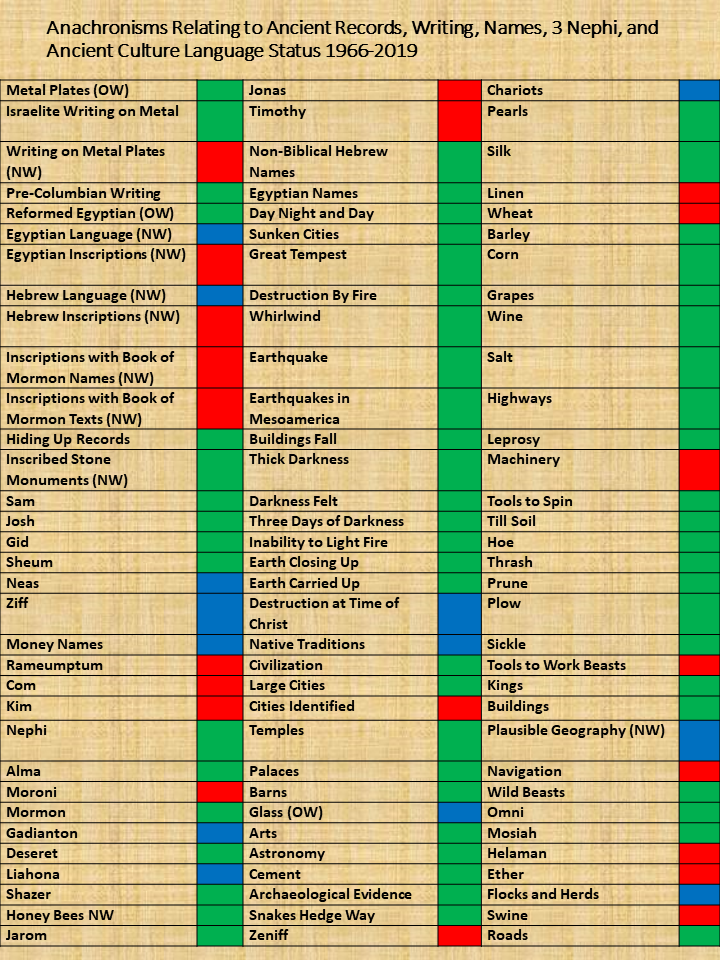
Notice the green again refers to confirmations. Red is not confirmed. And the blue is trending toward confirmation. So here—I don’t have time to read all these on the list, but there’s quite a few here as you can see, and this is the second page of the chart. So I find this kind of interesting to me, just because of when I started this, this third period, to see how much has happened. And the thing that really surprises me, and it did surprise me, because I didn’t expect to see so much of this, is the acceleration of confirmation of things that were once considered too silly for words about the Book of Mormon. And again, I’ll be publishing the documentation on these later this year, but I wanted to give you an idea here of what it looks like.
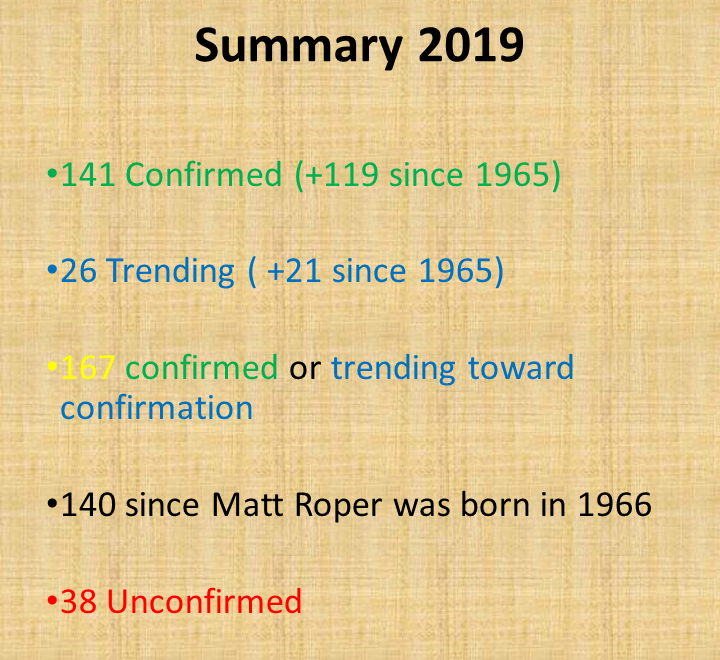
So by 2019 144 confirmed, that is plus 119 since I was born (1966); 26 trending, plus 21 since 1965; 167 have been confirmed or trending toward confirmation; 140 since Matt Roper was born; and 38 still remain unconfirmed. So there’s still things that we have not found any archeological or other evidence for.
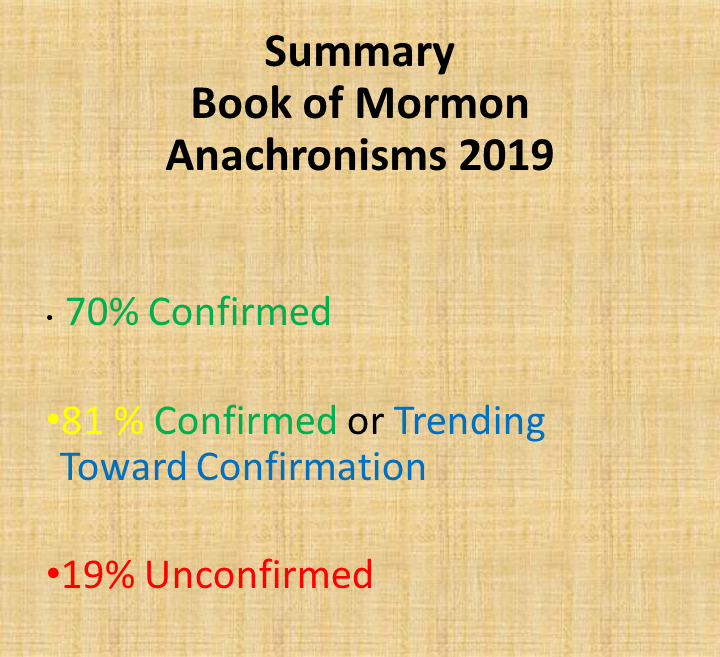
To put it another way, though, 70% have been confirmed; 81% are either confirmed or trending toward confirmation; and 19% unconfirmed. Now again we’re just talking about anachronisms.
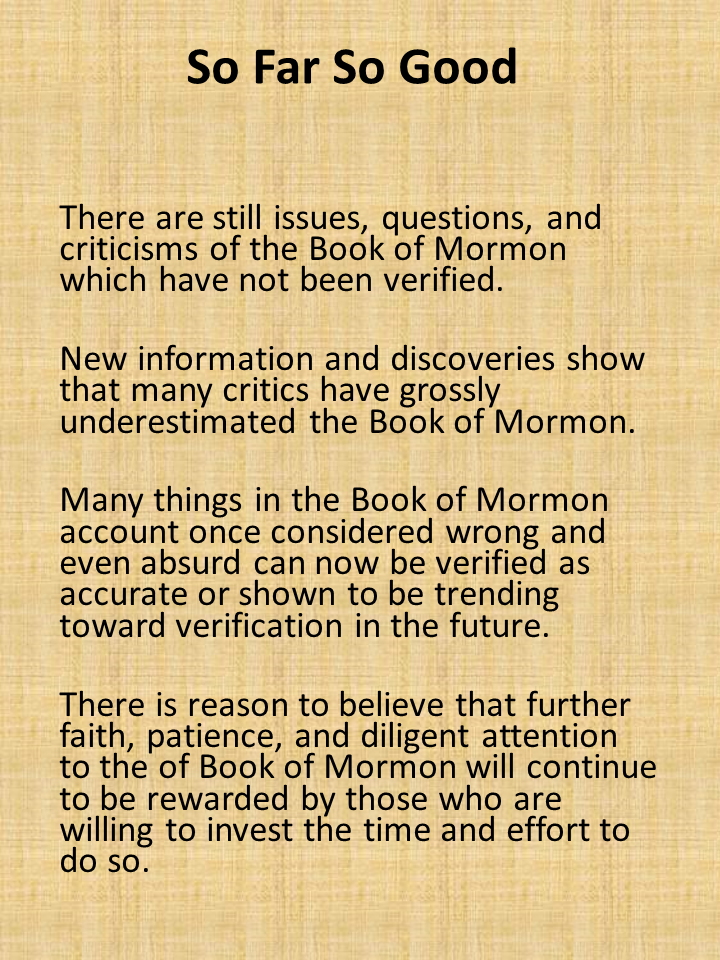
We’re not talking about all of the questions, or criticisms, or things that a person might raise about the Book of Mormon. But when somebody tells you, well, if the Book of Mormon is true, why haven’t we found horses? Book of Mormon can’t be true because it mentions steel swords. Well, from my perspective, I can testify, being born in 1965, to having seen plenty of confirmations of things that were thought too silly for words. And I can see that a lot has happened just in that period of time, just in the last 53 years.
So let me ask you, what is the next 53 years going to hold in terms of what we learn about the Book of Mormon? I like that Brother Richard Terry talked about the importance of patience. There are still issues, questions, and criticisms of the Book of Mormon which have not been verified. But new information and discoveries show that many critics have grossly underestimated the Book of Mormon. It’s obvious this is the case. It’s there. Many things in the Book of Mormon account once considered wrong or absurd can be verified and shown to be accurate or trending toward verification in the future. Because of this, there is reason to believe—plenty of reasons to believe I would say—that further faith, and patience, and diligent attention to the Book of Mormon will continue to be rewarded by those who are willing to invest the time and effort to do so.
Now I want to say a word about those items which are not confirmed. When I have a question about the Book of Mormon, and I’ve had many questions, and I still have many questions about the Book of Mormon, things that I can’t answer. Okay? When I have a problem with the Book of Mormon, I try to see in other disciplines, whether archaeology, history, which are kind of the areas that I’m more familiar with, how have those scholars dealt with similar types of problems in their field of study? Okay? So take it out of the controversial realm for a minute. How do you deal with these kinds of problems? And it’s helped me to look at what others have said.

Let me read you what one biblical archaeologist, a very prominent, very good biblical archaeologist, Kenneth Kitchen, has talked about in biblical archaeology. Think about the Book of Mormon and archaeology when we talk about this. “In the field of history, whether it be the patriarchs, or David, or anyone else, we are repeatedly told that no extra-biblical occurrences of this or that individual have been found, so their historicity is to be dismissed or treated as doubtful, regardless of all other indications.” What does that sound like? Have you ever encountered that kind of an argument with the Book of Mormon? “No such wrong criterion is applied elsewhere — why here? Absence of evidence is not, and should not be confounded with evidence of absence.”

“The same criticism is to be leveled at the abuse of this concept in archaeology: the syndrome: ‘we did not find it, so it never existed!’ instead of the more proper formulation: ‘evidence is currently lacking; we may have missed it or it may have left no trace;’ particularly when 5 percent or less of a mound is dug, leaving 95 percent or more untouched, unknown, and so, not in evidence.” So there’s some wisdom there from an archaeologist of the Bible, which we can apply to the Book of Mormon.
See how we phrase things? Instead of saying, why isn’t there this? Or we haven’t found this, so it can’t be true. Say, well, evidence is currently lacking. But there may be a number of reasons why that’s the case.

Another thing about unconfirmed items is just because they haven’t been confirmed by archaeology, doesn’t mean we don’t have an explanation for why that may not have happened yet. But that’s another discussion.
Finally let me just—before I turn it over to Kirk Magleby here—I want to share something from Elder Neil A. Maxwell, who talked about evidence and faith. And this is just to kind of give you perspective and hope, and remove a little bit of the fog as you keep in mind what we’ve just talked about.
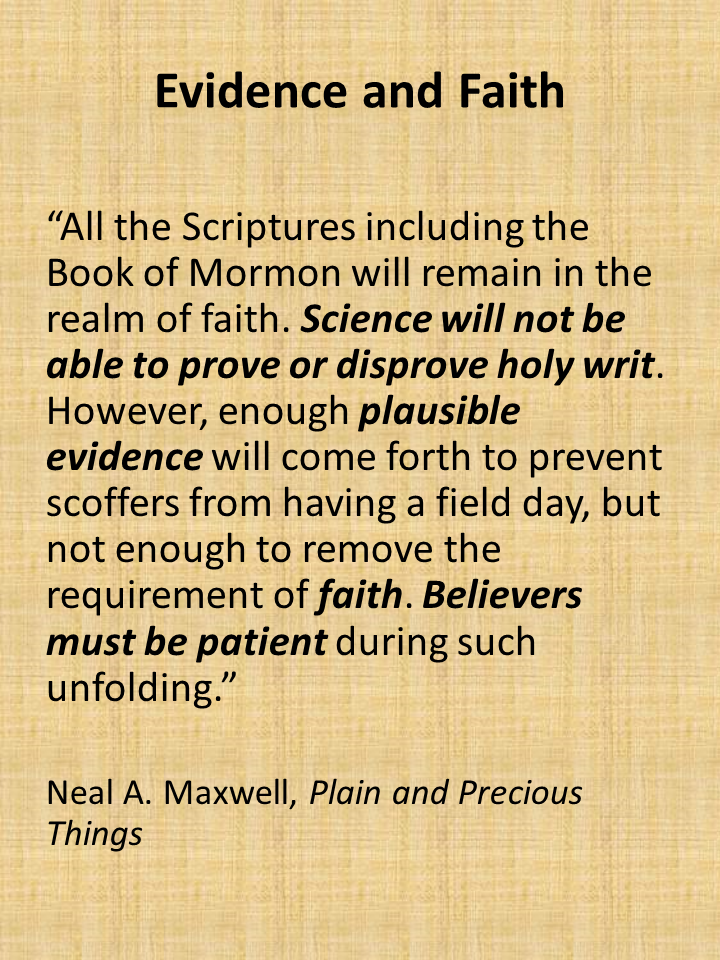
He says, “All of the Scriptures including the Book of Mormon will remain in the realm of faith. Science will not be able to prove or disprove holy writ. However, enough plausible evidence will come forth to prevent scoffers from having a field day, but not enough to remove the requirement of faith. Believers must be patient during such unfolding” just like Brother Richard Terry said.
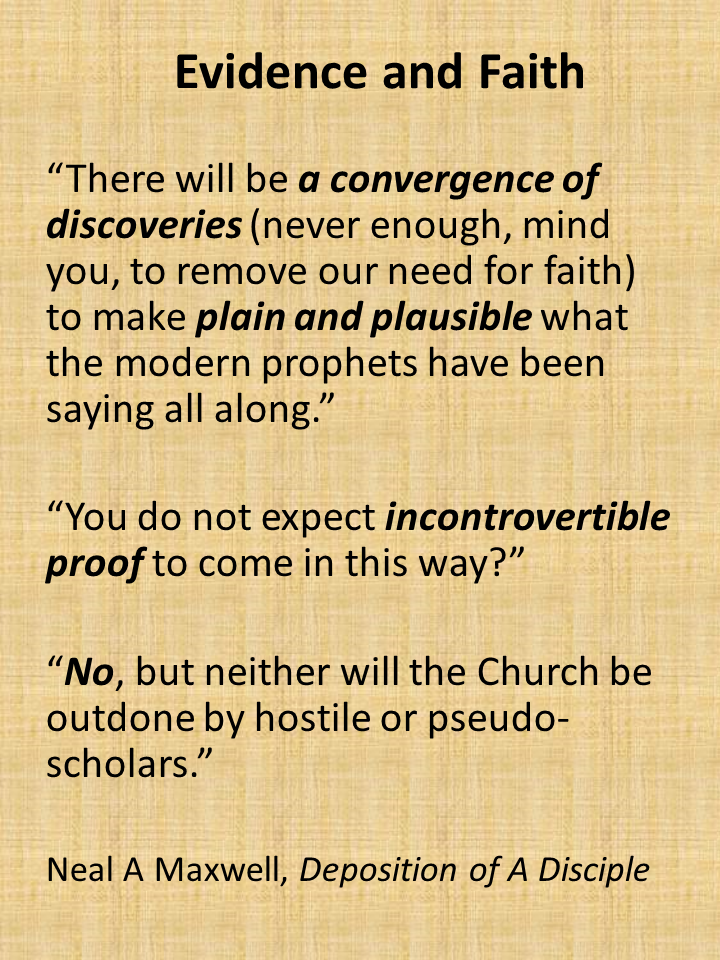
“There will be,” however, he says, “a convergence of discoveries (never enough, mind you, to remove our need for faith) to make plain and plausible what the modern prophets have been saying all along.”
“You do not expect incontrovertible proof to come in this way?”
“No, but neither will the Church be outdone by hostile or pseudo scholars.”
So I like that and submit that to you from Elder Neil A. Maxwell.

I’m going to turn this over to Kirk now, but I just wanted to leave this with you to give you a perspective, and again publish the documentation later this year and make it available. But I just want to suggest to you, brothers and sisters, that the mist obscures a lot of things. And as we look to the past and see where we’ve been, we need to take that into account as we wrestle with challenges today. But we have hope for the future as we see that more is coming, until eventually the Lord comes and he’ll reveal it all. But in the meantime, we need to prepare ourselves, and learn more, and exercise our faith in what we have. And I leave that with you in the name of Jesus Christ, Amen.
Kirk Magleby:

August 2019
Thank you, Matt. Time vindicates the prophets. That was an old radio show from 1954. Those are Hugh Nibley’s words.
I’m going to go through some of the more recent things that have shown this same phenomenon that with hard work and over time, we in fact can come to some strong conclusions about the historicity of ancient restoration scripture.
This is a book that was published in 2009 by former Senator Bob Bennet. He had experience before becoming a U.S. Senator in forensic investigations, forgeries such as the Howard Hughes will. He applies standard investigative techniques towards the Book of Mormon and concludes that it could not have been a forgery, because it fails all the standard tests for forgeries.

These are KnoWhys. We began to publish KnoWhys on January 1 of 2016. We published 527 KnoWhys in English. Five hundred and twenty-five of those have now been translated and published in Spanish. This is the most accessible corpus of Book of Mormon scholarship in this dispensation, the most impactful. Well over 1 million people have now interfaced with these KnoWhys.

When we very first came up with this rather unconventional name, we said, it will come to have meaning in our culture as we do our work well. And that’s very true. The Church itself is now producing the equivalent of a KnoWhy, including the little signature phrase we have at the end, “And now you know why.”
In 2017, Matt Cutler, who’s in the audience today, began to produce for us a series of videos. We put up our own YouTube channel. These are what we call our evidence videos. They’ve had well over 800,000 views up to this point. These are high-production quality videos, and they walk through a number of evidences of the Book of Mormon in a very compelling way.

We published in 2017 a book that was a compendium of the first 137 KnoWhys. This takes us about through the middle of Alma, and this has been a nice addition to our repertoire.

We then have a blog at Book of Mormon Central, and we highlight a number of things that show how trending, archaeological, historical, linguistic, and literary sorts of evidences are coming together to show the Book of Mormon to be authentic ancient history. This one happens to be one of our more popular blog articles that resulted from the Pacunam LiDAR survey that broke in February of 2018. National Geographic made a special about this, and it was all the rage. It went viral very, very quickly, and we showed how it was strong evidence that the Book of Mormon had in fact been corroborated to a large degree by what we’re now finding in the jungles of Guatemala.

We really like Matt Bowen. You’re going to have a chance to hear from him right after Jasmin Rappleye’s presentation on our Scripture-Plus product. But this is really, really good stuff.

After Pacunam LiDAR comes out with National Geographic, the work is not done. They’ve got to go out and get archaeologists on the ground to go to ground truth what the airborne surveys showed. And that came out in September of 2018 in the Journal of Science. This is my blog, where I went through and itemized some of the things I found and reported. And it is remarkable. Virtually everything that we wondered about fortifications in the Book of Mormon have now been corroborated by this particular study.

There’s a wonderful lady who’s now in her 91st year, and she published this book called The Challenge the Book of Mormon Makes to the World when she was 90 years old. This just came out in November of this last year. She took Hugh B. Brown’s old challenge to the Book of Mormon, first articulated in 1955, and did a book-length treatment on it. Delightful reading material. We had a lot to do with this, but kudos to Grace Jones. And this really helps us somewhat understand why Joseph Smith simply could not have written this book.
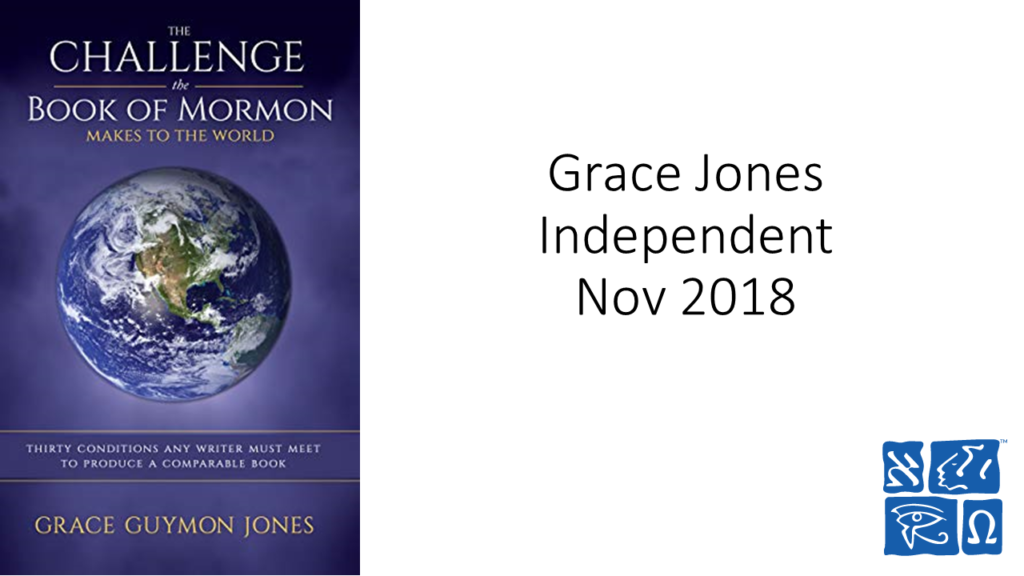
Then this book that came out in February of this year. We love Elder Tad Callister’s current book. And you’ll get to hear him on Friday. So he’ll be right before Dan Peterson’s closing remarks on Friday talking about this very book. It’s terrific. And there’s just no question: there is a very, very strong case to be made for the Book of Mormon.

Now I really like this article, and hats off to Dan Peterson and his team there at Interpreter that had the guts to publish this. We’ve got a couple of engineers here who said, you know what? Let’s go take a look at statistical analysis and see if the Book of Mormon really fits in ancient Mesoamerica context. And they came up with a probability number that was off the charts. The probability is extraordinarily high that this book fits in this ancient context. Well, the naysayers, and the critics, and so forth had a field day. And I have it on good authority that this is the most heavily commented article Interpreter has ever published.

So the author came to our office a few weeks ago. We sat down and went through all the comments, pros and cons, that were accruing on this very interesting article. And here’s what we decided to do, and this is his closing argument now, as Allen Wyatt’s shut down comments on this particular thread.
We went back to the very first edition of the book that he had used as his starting point for analysis, the ninth edition of The Maya by Coe and Houston. Went back to the first edition published in 1966, and this is an example of what Matt Roper was just talking about. Over time, with an authentic, ancient, historical document, the evidence gets much, much stronger. So the Dales found 79 correspondences in the 1966 edition of this book. They found 131 correspondences in the ninth edition. And of the 79 correspondences in 1966, 30 of them are much, much stronger by the time we get to the 2015 edition. This is a very good example of this phenomenon—time vindicating the prophets.
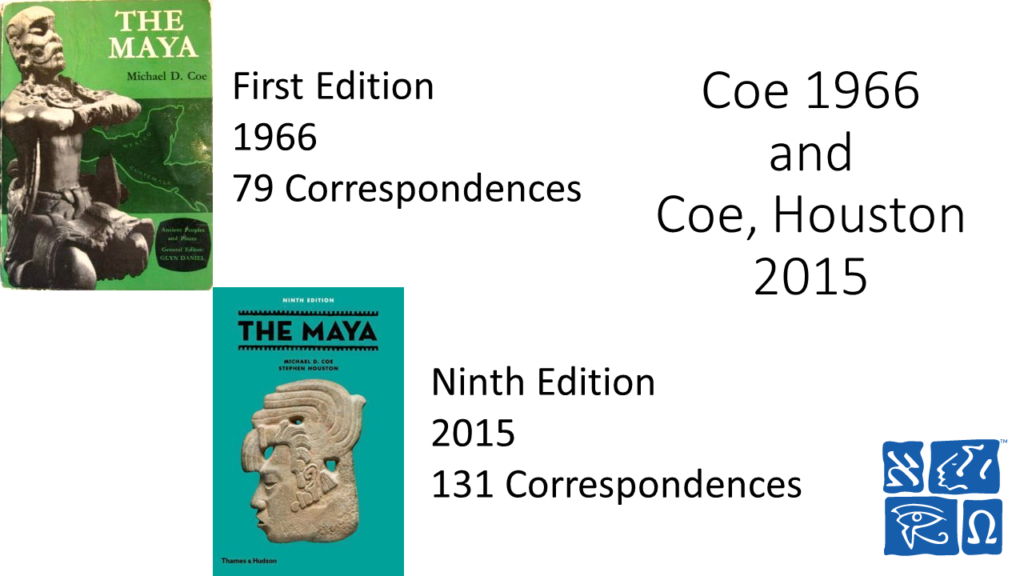
Current Maya scholarship currently supports this conclusion that there’s a strong affinity between the ancient Mesoamerica context and the Book of Mormon. And I would point you to these three resources right here. And they are remarkable what they put on the table. They’re very, very recent. They’re very cutting-edge stuff, and it demonstrates that something is going on here. Very precise. In some cases, it’s almost like paraphrasing what’s in the Book of Mormon. And much of this because we now can read Mayan texts, and they’re coming forth in droves, and it’s very exciting. Some of these Mayan texts actually go back into very close to Book of Mormon times.

What would it be like if we could actually have an ad campaign out across the internet to get people to read the Book of Mormon? We’re doing that at Book of Mormon Central. In the last 90 days we’ve shared 6 million ad impressions, and we’ve driven a lot of traffic back to our website. And this is all about the Book of Mormon, clear and convincing. The Book of Mormon will change your life. The Book of Mormon, beautiful, miraculous, true—these sorts of things.
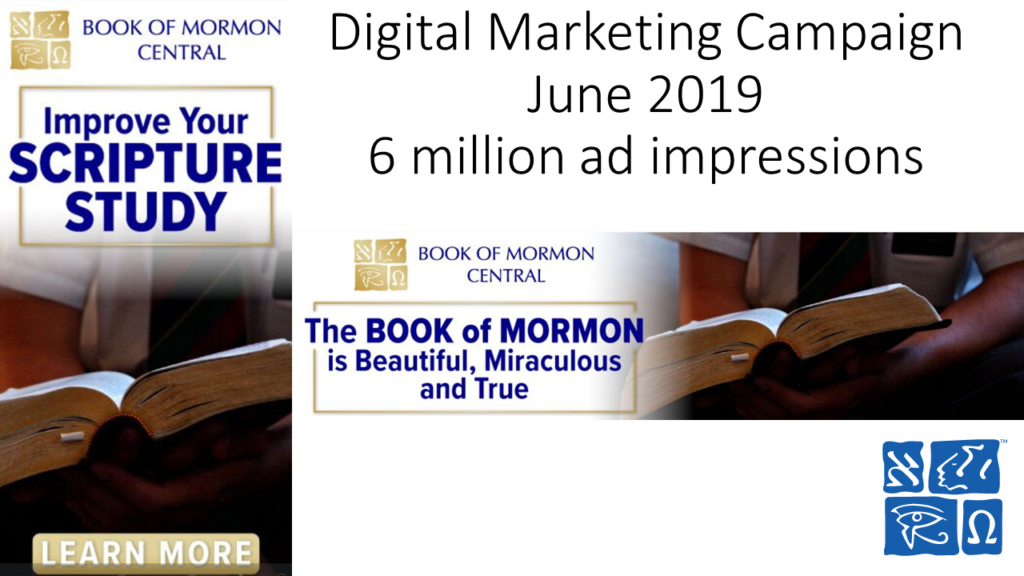
We took a team down to San Diego in February to learn digital marketing, because it was a bit of weak spot in our organization. And you’ve seen the first results of that now beginning to happen. Some of you may have seen some of these ads.
Big reveal—drum roll. We’re going to make history. The Church came to us at the end of last year and said, Book of Mormon Central, can you help us with the Book of Abraham, because we’re getting completely ambushed by the forces that arrayed against us out there on the internet. They’re making it too easy for our kids to go out there and be ensnared and deceived, and led into a rabbit hole of fear, uncertainty, and doubt. They’re making it too easy to tell the story that Joseph Smith was this, or Joseph Smith was that, or Joseph Smith didn’t know this, or that Egyptologists don’t corroborate with this, or don’t agree with this anymore.
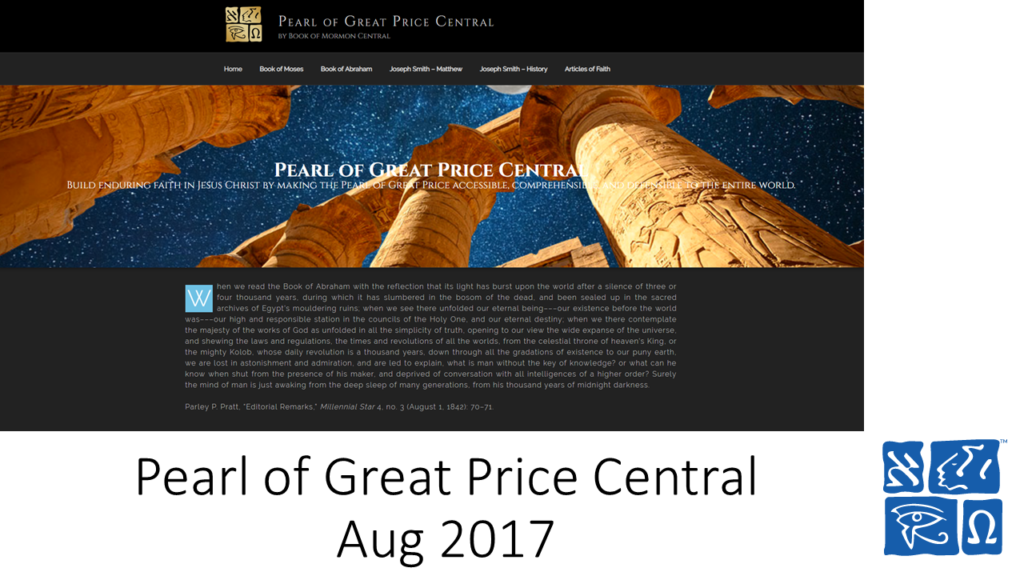
We’ve been patiently working now for eight months, and we announce today, you were here, you saw it, you were part of this, it went live about four hours ago—Pearl of Great Price Central. It’s visually striking. It has a tremendous bibliography. Some of the most important faithful scholars in the Church have collaborated with us on this project. John Gee I talked to earlier here today, he’s been part of this project; Kerry Muhlestein, terrific Egyptologist; and John Johnson, who’s currently Institute Director back in Cambridge; all wonderful credentialed brethren.
What we’ve done is bring together for the Pearl of Great Price, specifically the Book of Abraham, some of the same kinds of resources we’ve been doing now for 3-1/2 years under Jack Welch’s direction with the Book of Mormon. So this is what you can find. In fact, bring it up right now on your mobile devices right there. It’s right there as we speak, Pearl of Great Price Central. And this is what you will find as you go down there.
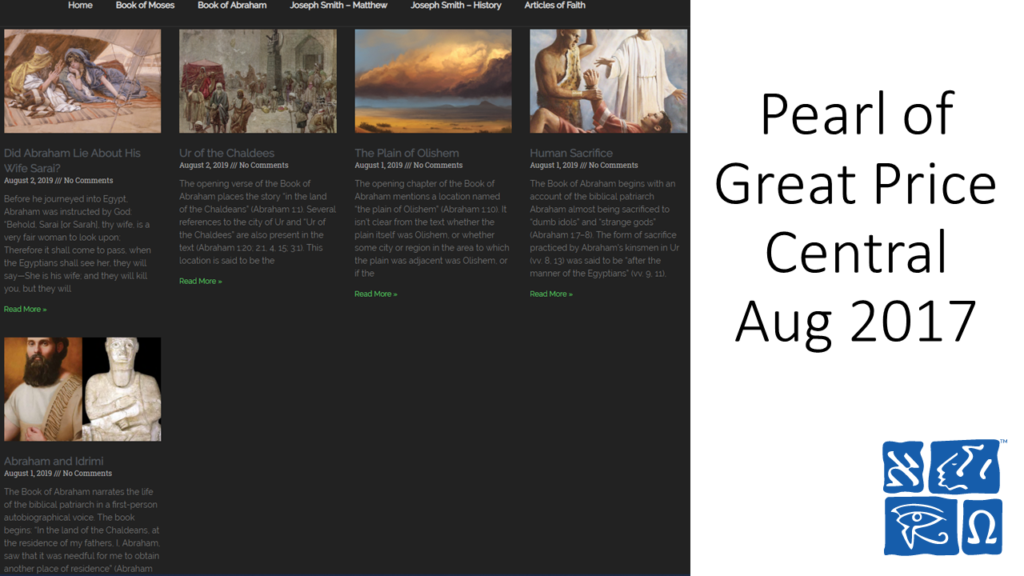
We’ve put five articles, five essays up now that talk about different aspects of the Book of Abraham. These are some of the five. We’ve got an essay here about did [Abraham] lie about his wife Sarah; The Ur of the Chaldees; the Plain of Olishem, one of the toponyms mentioned in the text; human sacrifice; and Abraham and Idrimi. There will be at least 40 of these articles. We’ve got most of them written already. We’re going to be publishing these approximately one a week now for the next several months as we roll this thing out. So come on back from time to time and check out what’s going on.
We’ve got a nice bibliography here on this site that has several different access paths. One thing that you’ll notice here going forward with the things that we’re going to be doing in the Book of Mormon Central, we’re paying a lot of attention to user interfaces. We haven’t had really high-quality user interface design up to this point. We’ve just sort of cobbled things together with graphic designers, done the best we could to throw up a Drupal site, or a WordPress site, or whatever. But we’re now beginning to pay series attention to UXD, user-interface design types of principles. And simply the way you build indexes into complex materials can make a big difference in the way an individual may or may not be able to find the stuff.
So this is an example of some of the things that we’ve done. We’ve made a nice collapsible index here into the bibliography. It’s all fully hyperlinked. Click on these things, it takes you to such places as Scholars Archive at BYU, where a lot of the good stuff is now headquartered, the RSC, the occasional Interpreter article, that sort of thing. Book of Mormon Central has just spawned Pearl of Great Price Central. And that gives you an idea of where we’re headed.
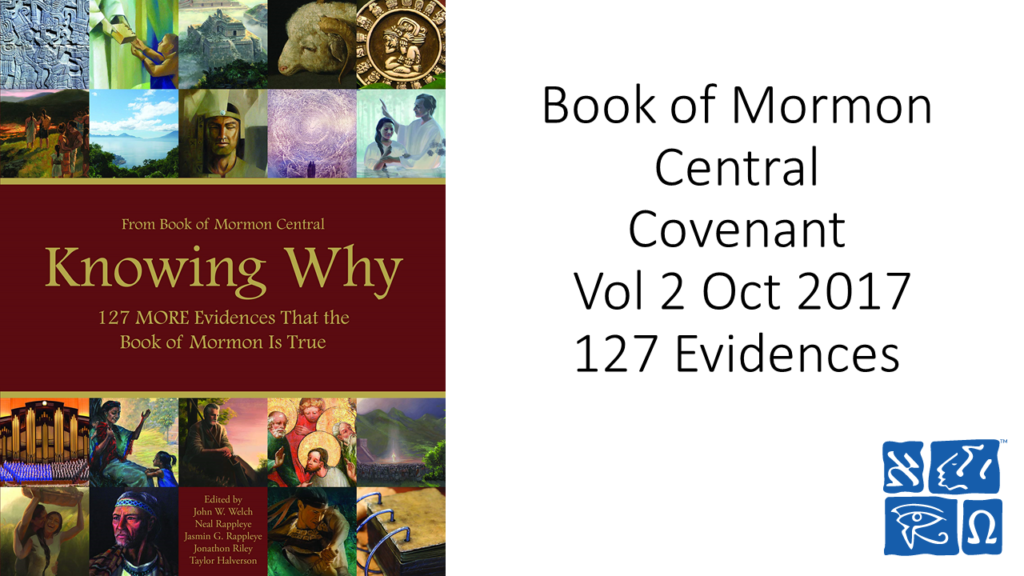
There will be a new book coming out in October of this year, actually that’s wrong on the slide. It should say October 2019. The second volume of the KnoWhy series. The next 127, it takes us through the second half of the Book of Mormon. So with these KnoWhys, we’ll now have a two-volume set, which will enable someone to get profound insights into the text of the Book of Mormon.
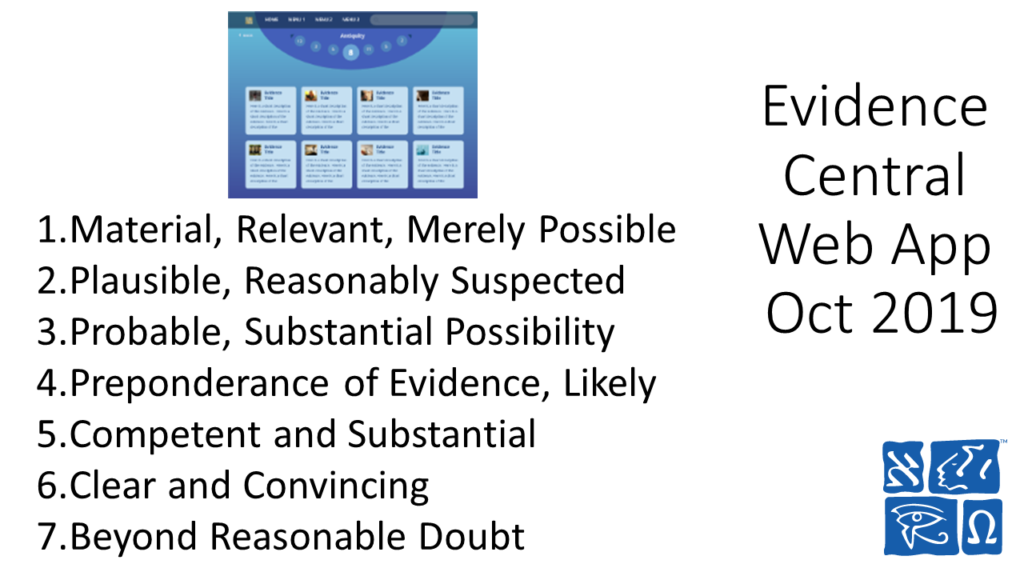
And then the other major announcement—well actually there’s even a larger announcement that Jasmine [Rappleye] gets to do here at the three o’clock hour. So come back for Jasmine. But we are publicly announcing, not unveiling yet, but publicly announcing a whole new paradigm in how to deal with evidences. It’s called Evidence Central. Evidence Central is a collaboration between Kara Legacy Foundation and Book of Mormon Central. We’re throwing everything that we’ve learned in the last 3-1/2 years into this thing. We’ve got the very best technology we can possibly get into this. We’ve got the very best design principles. And we’re using what Jack Welch has learned over the last 40 years. Can you imagine? He’s been on the faculty of the BYU Law School for 40 years now. And we’re taking what he has learned about the evidentiary process, and about making things through this burden of proof hierarchy that starts out with something that’s merely possible and gets all the way down to something that’s beyond reasonable doubt.
And we’re making this into a system, whereby people can have a safe haven, where they can send time with faith-affirming, positive, uplifting, evidentiary material that will strengthen testimonies and strengthen faith and have a really, really fun time doing it. The forces arrayed against us have become so good at entrapping our youth.
I heard a sad story the other day from a fellow who is on the faculty at the BYU Religion department. He said a mom brought her return-missionary son into my office. He’d taken off his garments. He’d said, I’m out of here; I’m checking out; I never want to be part of this again. She wanted him, before he actually walked out the door, she wanted him to go talk to this particular religion professor. And he asked him one question. He said, so tell me how you spend your time online? How much time do you spend with the Book of Mormon every day? Zero. How much time do you spend with sites which are calculated to deceive you, and lead you astray, and fill your mind with darkness every day? And it was a vast amount of time that this young man was spending with these kinds of sites. Why do they do it? Because they’re enticing. Because there’s entrapment going on. Because there’s psychological principles at work here, which make this addictive, sticky sites, just like a video game. You want to go back and do it over, and over, and over again.
We’ve been negligent, those of us who care about our youth and who care about the future of this church, and who care about the truth, and who care about restoration scripture. We’ve been negligent about providing this same kind of very immersive, experiential-based technology to the students of the scriptures. We’re solving that with this particular project.
Evidence Central, which we’re announcing today but it won’t be available until October, and Ryan Dally is here in the audience. He’s the Director of Content for Evidence Central. And we are bringing together content and technology in such a way that a person will be able to go in and spend a tremendous amount of time, have a great time doing it, access things from many different angles, many different perspectives, lots of different indexes, with all kinds of points of departure to get back into the good stuff and yet be affirmed in their testimony, and have things corroborated in their mind, and have it make sense, and have this be logically and intuitively satisfying to them as they go through. That is Evidence Central. That’s what we’re all about right now at Book of Mormon Central. It’s been quite a ride. You’re going to hear a lot more about that with our [ScripturePlus] Mark-E project coming up in the next hour. But God bless us, everyone.
FairMormon is doing remarkable work—we love these guys—as is Book of Mormon Studies; as is the Interpreter Foundation organization; as is the LDS Perspectives podcast with the Hales; as are many, many other wonderful organizations. It’s been such a thrill to see the Joseph Smith Papers Project progress the way it has. To see the Church Historian’s office begin to produce something as good as Saints. We love the Saints volume. This type of history is what we’ve needed for a long time, and the fact that we’ve now got it, bless those inspired leaders, who are allowing our historians to do work of this high a caliber, and this high quality, and this inclusive nature.
And we at Book of Mormon Central are trying to do our part to hold up our end of the bargain, because the Book of Mormon is worth everything we can possibly do. It’s worth our very, very best effort.
This is our mission statement at Book of Mormon Central, we build enduring faith in Jesus Christ by making the Book of Mormon accessible, comprehensive, and defensible to the entire world. And now this is the mission statement of the Pearl of Great Price Central. We build enduring faith in Jesus Christ by making the Pearl of Great Price accessible, comprehensible, and defensible to the entire world. In the name of Jesus Christ, Amen.
Q&A
Q – Kirk Magleby: The first question I got was “so what is the URL?”
A – Kirk Magleby: The link is pearlofgreatpricecentral.org. Not .com; .org. Pearl of Great Price Central is all spelled out. pearlofgreatpricecentral — it’s a mouthful. Just think Grand Central Station, all trains come into the one big train station. This is the sum of all knowledge. This is the consortium of all the good resources out there—a one-stop shop— pearlofgreatpricecentral.org.
Q – Kirk Magleby: Please tell the rest of the story about the mother and her RM son.
A – Kirk Magleby: Well, this RM son was very impressed with some of the things he found on the Book of Mormon Central website, and we can only hope and pray. He hasn’t put his garments back on yet as far as I know.
Q – Kirk Magleby: What are the plans for translating Book of Mormon Central, Pearl of Great Price Central, Evidence Central to other languages, especially German?
A – Kirk Magleby: All right. We’re publishing in Spanish. We have done since 2017. It takes us about $20,000 a month to run our Spanish organization. We made a run at Portuguese here a little while ago, and we just decided we didn’t have the financial resources to make a go of it. I cannot get into a language until I do it right. Here’s the problem, this isn’t just translation. I can’t just hire any old Tom, Dick, or Harry to translate this. This is not LDSLiving sorts of relatively fluffy stuff. Okay? We’re talking scripture; we’re talking history; we’re talking—
Scott Gordon: You’re going to get in trouble here you know.
A – Kirk Magleby: Well, you’re going to deal with this my friend, but in order for me to translate into Spanish and have actual verifiable results, I need to have translators who have master’s degrees in Biblical studies from bona fide religious institutions. Noah Cararris was in the audience earlier today. He’s one of our translators. It takes full-time people. My lead translator has a PhD basically. It takes serious folks to do the sorts of translation in order for us not to have street talk, in order for us to have actual sorts of things that scriptural scholars will respect. Okay? And that’s our trademark of what we do at Book of Mormon Central.
So Jack Welch would love nothing more than getting it into German, I assure you. But Portuguese is next on our list, because that’s where the large number of Saints are, and it’s all a matter of us being able to generate the donor support that we need to be able to put an organization together. We’d do it that fast if we could.
Q – Kirk Magleby: When will Book of Mormon Central now Pearl of Great Price Central be taken down by Google?
A – Kirk Magleby: Oh, this is so interesting, We were already taken down by Google. When we launched on January 1 of 2016, we had made the mistake of announcing that we were going to be on YouTube. Well, we put up the first video on YouTube and a whole bunch of haters went out there and immediately complained to Google that we’re spamming them. Well, Google took our YouTube channel down like that. If you go in there and actually seriously look at our YouTube channel, it now has millions of views and hundreds of videos and so forth, you’ll see that we published 20 videos on the 27th of January. And we had to literally go to the Bishop of the singles ward in Palo Alto, California who has a bunch of Googlers in his ward, and we had to go plead our case. And it took us quite a while for us to actually get our YouTube channel back up and operational from Google itself.
Could they take us down? We have some insiders. Okay? It was about a year or so ago, no, a little over a year or so ago that we took a delegation down to Google. And that led directly to the project you’re going to see here in a few minutes. But we met with some senior people who are good, faithful Latter-day Saints, and we’ve maintained that relationship since.
Google just gave us a grant to actually use their ad network to publicize Book of Mormon sorts of things. We thought that was pretty cool. We haven’t begun to take advantage of it yet, because I need to go out and get somebody who’s a real expert in Google ad words to be able to really make use of that donation.
But nonetheless, as of right now we think we’re okay moving forward with this. I showed the ad campaign out there. Half of that ad campaign is going to YouTube. And we’re promoting some of our very top YouTube videos with YouTube advertising right now, and that puts money directly into Google’s pockets. So money talks.
Q – Matt Roper: I’ll just take two. I’ve only got time for just a couple here. First of all, how is the bow and arrow confirmed in 1830 to 1844 but is trending today?
A – Matt Roper: Okay. Well remember what I’m taking is what the critics actually said. Sometimes the critics say lots of things. But what happened is in Joseph Smith’s day there were critics that were saying they didn’t have the bow and arrow in what would have Book of Mormon times. What we’ve seen, however, is a trend in more and more. So they had bow and arrows. The critics didn’t really specify when they needed to have the bow and arrow, but they’ve since been more specific, and so we have to address that criticism. So it was listed as initially confirmed, but there’s a separate category for bow and arrow early on the chart to deal with what the subsequent critics have said.
Q – Matt Roper: How do you rate horses in the Book of Mormon?
A – Matt Roper: I would rate horses as trending. The reason for that is because beginning in Joseph Smith’s day people were saying throughout much of the 19th century there never ever were any horses in the Americas before Columbus. That was the initial argument. Then when Latter-day Saints started noticing, oh, there are these discoveries where we found these horses, the critics said, well, yeah, but it wasn’t contemporary with man. Then they found some that seemed to be contemporary with man, and they said, well, yes, but it’s still too early for the Book of Mormon.
Well now what we’ve found we even have a number of examples of horse bones being found that they’d past the Pleistocene time. So it’s past 9,000 or 8,000 B.C. down into just a few thousand years ago. And there are examples of that. There’s still a ways to go on that in terms of further south, and finding these. And Brother Terry talked about some of the issues there. So it is a trending. The same with the elephant, I would put that in.
Q – Matt Roper: And just one last thing here, when are the charts going to be published? Trying to find the set from 13 years ago was like the sealed portion of the plates.
A – Matt Roper: Indeed. And you have no idea. When I changed jobs three years ago, I almost lost the entire file that I had those. Fortunately, I had backups, so we were able to do that. So yes. I’m not entirely sure. We’re probably going to incorporate that into what we’re doing with Evidence Central, but I also intend to get all the information together for this project all in one place and make it available later this year regardless. So thank you.
Kirk Magleby: We just sent Jonathan Riley, who used to be in charge of our KnoWhy production back to the Catholic University of Washington to get his PhD in Biblical studies. Matt Roper is now taking over. So he’ll be responsible for publishing KnoWhys. You’ll see all kinds of good stuff coming from Matt Roper here soon.
[Note: Transcript lightly edited for clarity and readability.]
